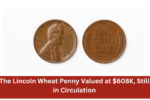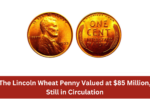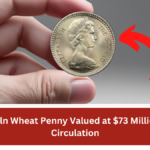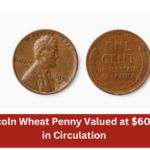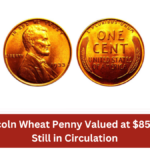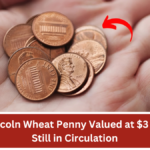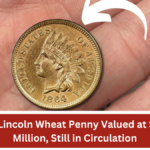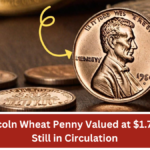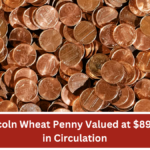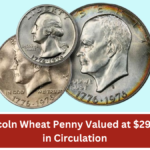The Lincoln Wheat Penny, first minted in 1909, holds a special place in the history of United States coinage. Designed by Victor David Brenner to honor Abraham Lincoln, it was the first U.S. coin to feature a president’s portrait. While most pennies are considered to be worth their face value, the Lincoln Wheat Penny is an exception, with its value in some cases soaring to incredible heights. Estimates suggest that the collective value of all Lincoln Wheat Pennies in circulation may approach $1.24 billion. Let’s delve into what makes these pennies so unique and valuable.
What is the Lincoln Wheat Penny?
The Lincoln Wheat Penny, also called the “Wheat Cent,” was minted from 1909 to 1958. Its obverse features Abraham Lincoln’s profile, while its reverse displays two stalks of wheat flanking the words “One Cent.” These pennies were made primarily from 95% copper and 5% tin and zinc. However, during World War II, in 1943, the U.S. Mint produced pennies from steel coated with zinc to conserve copper for the war effort.
Key Features of the Lincoln Wheat Penny:
- Obverse Design: Abraham Lincoln’s profile, designed by Victor David Brenner, with the words “In God We Trust” above, “Liberty” to the left, and the date to the right.
- Reverse Design: Two wheat stalks framing the words “One Cent” and “United States of America,” with “E Pluribus Unum” above.
- Material: Primarily copper, except for the 1943 steel pennies.
- Mint Marks: Found below the date, including “D” for Denver, “S” for San Francisco, and no mark for Philadelphia.
Rare and Valuable Lincoln Wheat Pennies
Certain Lincoln Wheat Pennies are highly sought after by collectors due to their rarity and unique features. Here are some notable examples:
- 1909-S VDB: Only 484,000 of these were minted, making it one of the rarest and most valuable Wheat Pennies. It features Brenner’s initials (VDB) on the reverse.
- 1914-D: With just over 1.1 million minted, this penny is another highly prized coin.
- 1922 No D: A minting error led to the omission of the “D” mint mark, making this coin rare and valuable.
- 1943 Bronze Penny: A few 1943 pennies were mistakenly struck in bronze instead of steel. These are extremely rare, with one selling for over $1 million.
- 1955 Double Die: A striking error resulted in doubling of the date and lettering, making it a favorite among collectors.
Why Are Lincoln Wheat Pennies Still in Circulation?
Despite being out of production for over six decades, many Lincoln Wheat Pennies remain in circulation. Their robust copper composition and widespread production (over 26 billion minted) have contributed to their longevity. Additionally, they are often found in collections, passed down through generations, or forgotten in jars of spare change. Occasionally, these historic coins resurface in everyday transactions or bank rolls.
Value of the Lincoln Wheat Penny
The value of a Lincoln Wheat Penny depends on its condition, rarity, and historical significance. Common Wheat Pennies in circulated condition are typically worth $0.03 to $0.10, while rarer specimens can fetch thousands or even millions of dollars. Graded and certified coins in mint condition or with unique errors often command the highest prices.
Frequently Asked Questions (FAQs)
1. How can I identify a rare Lincoln Wheat Penny?
Rare Wheat Pennies often have distinguishing features, such as specific mint marks (e.g., “S” or “D”), errors (e.g., double dies, missing mint marks), or low mintage years. Referencing coin guides or consulting a professional appraiser can help identify valuable specimens.
2. What makes the 1909-S VDB penny so valuable?
The 1909-S VDB penny is valuable due to its low mintage (484,000 coins) and historical significance as the first year of the Lincoln Wheat Penny series. The initials “VDB” (Victor David Brenner) on the reverse add to its appeal.
3. Are all 1943 pennies valuable?
Not all 1943 pennies are valuable. Most were made from steel and are worth a few cents. However, a few were mistakenly struck in bronze and are extremely rare, with values exceeding $1 million.
4. How can I determine the value of my Lincoln Wheat Penny?
The value depends on the coin’s condition, rarity, and demand. Use a coin value guide or have the penny graded by a professional coin grading service (e.g., PCGS or NGC) to determine its value.
5. Where can I sell my Lincoln Wheat Pennies?
Lincoln Wheat Pennies can be sold to coin dealers, at coin shows, through online marketplaces (e.g., eBay), or via auction houses specializing in rare coins. Ensure you research the buyer and market value beforehand.
In conclusion, the Lincoln Wheat Penny remains a fascinating and valuable part of American numismatics. Whether you’re a seasoned collector or someone lucky enough to find one in your pocket change, these coins offer a tangible connection to history and the potential for significant financial reward.


